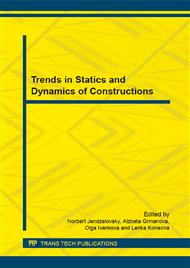p.81
p.85
p.91
p.97
p.101
p.107
p.112
p.118
p.126
Integral Representation of Constitutive Equations in Linear Theory of Viscoelasticity
Abstract:
The presented paper delas with constitutive equations of the linear theory of viscoelasticity. The integral representations for homogeneous isotropic medium located in isothermal conditions are introduced. Relations are derived for the relaxation and creep processes, as well as relations between these functions in the Laplace images. In the solution we assume quasi-static external force loading under which the analyzed viscoelastic body in each time t shows infinitesimal deformations. General isotropic tensor of fourth degree Gijkl (t) we use to derive the relationship between deviator stress and deformation, as well as the relations between stresses and distortions that produce volumetric changes. It is shown that for the linear viscoelastic problem can be used Stieltjes convolution and its algebraic properties. Derived relations and procedures followed to the results of differential-operator's representation of constitutive equations of linear viscoelasticity theory that have been published in the previous work of Authors.
Info:
Periodical:
Pages:
101-106
Citation:
Online since:
June 2015
Authors:
Price:
Сopyright:
© 2015 Trans Tech Publications Ltd. All Rights Reserved
Share:
Citation:


